Papers by Julio C . Postigo
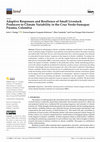
Land, 2024
Enhanced anthropogenic climatic variability challenges small farmers. In the Sumapaz
páramo (Colo... more Enhanced anthropogenic climatic variability challenges small farmers. In the Sumapaz
páramo (Colombia), higher irregularity in precipitation and temperature reduces the quality of pasture
and cattle health. Data from surveys, semi-structured interviews, and focus groups were analyzed
to understand livestock farmers’ responses to the impacts of climatic variability. To estimate the
communities’ resilience in the páramo, we used the capitals framework, the Baseline Resilience
Indicator for Communities (BRIC), and cluster analysis. The responses of most households aim to
reduce the impacts of climatic variability on the production system, chiefly intensifying practices
such as the rotation of paddocks, livelihood diversification, purchase of grass, and buying and selling
livestock. Interestingly, farmers did not recognize the value of the types of capital for responding to
climatic variability. Results showed that the use of available physical, social, and economic capitals
render the farming system resilient. Our probit model estimated that economic and human capitals
are the largest and most significant contributors to communities’ capacity to respond to climatic
variability. However, pre-existing non-climatic vulnerabilities are also important. For example,
poverty hinders farmers from using their income in response to climatic variability. The place-based
measurements used in this research are easily understood and applicable by local policy makers to
address increasing climate variability.
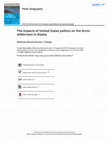
POLAR GEOGRAPHY, 2024
The Arctic National Wildlife Refuge (ANWR or the Refuge) has been at
the core of the conservation... more The Arctic National Wildlife Refuge (ANWR or the Refuge) has been at
the core of the conservation-development debate in the U.S. for over
fifty years. The Refuge case epitomizes how policies shape territories
governed by overlapping federal, congress, local, and Indigenous
regimes. For instance, between 2017 and 2023, the Refuge was
opened and closed to hydrocarbon development by two U.S.
Presidents. ANWR is among the largest environmental refuges in the
U.S. with oil reserve between 4.3 and 11.8 million barrels. Our
analysis of U.S. policies about the ANWR shows the contestation
between pro-environment and pro-oil development at the federal
and state levels. Federal policies of Republican and Democrat
administrations align with pro-drilling and pro-environment
positions, respectively. Alaskan policymakers are pro-drilling, which
puts them at odds with pro-environment legislators from
Democratic states. Tensions between Alaska and the Federal
government are about control and distribution of the oil revenue.
Further, Indigenous peoples are on different sides as well.
Traditional Gwich’in oppose development because it threatens their
way of life. Iñupiat favor oil development because oil revenue has
supported their modernized lifestyle. The fate of the ANWR will
shape what happens with protected areas in the U.S. and with
species across national boundaries.
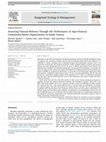
Rangeland Ecology & Management, 2024
Pastoralism is one of the most important agricultural production systems in drylands worldwide. I... more Pastoralism is one of the most important agricultural production systems in drylands worldwide. It plays an important role in both the economy and the cycle of ecosystem goods and services. However, it is vulnerable to climatic challenges such as prolonged drought and socioeconomic pressures such as administrative shortcomings and ineffective governance. Under neoliberal influence, political and economic reforms have been implemented over the last 30 years to address these threats. These reforms have promoted local institutions for rangeland management and agro-pastoral development. In this paper, we assess the impact of these reforms on pastoral devolvement and Community-based natural resource management (CBNRM) by analyzing the performance of agro-pastoral community-based organizations CBOs in the province of Médenine (south-eastern Tunisia). We use a two-step methodology, with the first step focusing on a quantitative typology analysis of the performance of 31 CBOs. In a subsequent qualitative step, data from semi-structured interviews with 21 CBO chairpersons were used to identify the drivers of CBO performance. Results show that only 10% of the CBOs studied are able to move towards autonomy and proper integration into local and regional institutional networks and development dynamics. About 42% of the CBOs need further support and are in a precarious situation as they are dependent on public support. The remaining 48% have a low growth potential and in the early stages of consolidation. The qualitative analysis suggests that these shortcomings are mainly related to the CBOs' lack of networking skills. In addition, CBOs should improve their reputation and gain more trust from pastoral communities. Our findings suggest that well-functioning institutions do contribute to rural development; however, the design of pastoralist policy and institutional reforms should include long-term complementary support for the institutions created and consideration of the pastoralist community and regional contexts in order to achieve long-lasting transformative outcomes.

Mountain research and development, Mar 7, 2024
The impacts of both climate change and socioeconomic processes are driving the degradation of mou... more The impacts of both climate change and socioeconomic processes are driving the degradation of mountains and the ecological services they provide worldwide. In the tropical Andes, compounding glacier retreat, altered hydrological and precipitation regimes (eg off-season alternation of extreme dry and wet periods), and expansion of mining and other land uses are modifying hydrological services. Although initiatives to restore ecosystems and their services are increasing, conceptual models emerging from experiences on the ground are scarce. Based upon the experience of Peru’s National Institute for Research on Glaciers and Mountain Ecosystems (INAIGEM) in the Piuray Ccorimarca microbasin (Cusco) in combining participatory action research and experiments at the plot scale, this article elaborates a conceptual model for the rehabilitation of hydrological services on the social–ecological systems of puna grassland. The model proposes multiscale (plot–pilot–microbasin) rehabilitation. At each level, the actions proposed include designing plots, selecting sites, implementing restoration activities, and evaluating and monitoring the sites. Our inductive model from the ground and plot can inform rehabilitation of hydrological services on puna grasslands elsewhere.
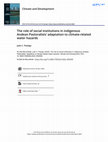
Climate and Development, 2020
Though Andean indigenous communities have a lengthy history of capable responding to water threat... more Though Andean indigenous communities have a lengthy history of capable responding to water threats, anthropogenic climate change and soaring water demand have changed preterit water challenges into serious hazards. Using an ethnographic approach, this study examines how a Peruvian indigenous pastoralist community perceived and responded to climate-change induced water threats with the goal of understanding the mechanisms that enable such responses. Pastoralists report that alterations in water availability diminish the size and quality of wetlands and pastures, thus decreasing fodder for their livestock. Their primary adaptive responses are the creation of wetlands and the movement of livestock. A set of nested dynamic and flexible institutions enable households and supra-household units to carry out adaptive responses by facilitating access to alternate grazing areas and the labour force necessary to reshape the landscape. Institutions and local knowledge supporting the responses are open to exogenous information which generates opportunities for collaboration and innovation in the face of water hazards which in turn foments the resilience of indigenous pastoral social-ecological systems. This study reveals how indigenous knowledge and institutions contain strategies for adaptation to water stress that may be scaled up and replicated in national and sub-national programs.
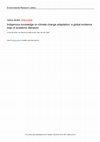
Environmental Research Letters, 2020
There is emerging evidence of the important role of indigenous knowledge for climate change adapt... more There is emerging evidence of the important role of indigenous knowledge for climate change adaptation. The necessity to consider different knowledge systems in climate change research has been established in the fifth assessment report (AR5) of the Intergovernmental Panel on Climate Change (IPCC). However, gaps in author expertise and inconsistent assessment by the IPCC lead to a regionally heterogeneous and thematically generic coverage of the topic. We conducted a scoping review of peer-reviewed academic literature to support better integration of the existing and emerging research on indigenous knowledge in IPCC assessments. The research question underpinning this scoping review is: How is evidence of indigenous knowledge on climate change adaptation geographically and thematically distributed in the peer-reviewed academic literature? As the first systematic global evidence map of indigenous knowledge in the climate adaptation literature, the study provides an overview of the evidence of indigenous knowledge for adaptation across regions and categorises relevant concepts related to indigenous knowledge and their contexts in the climate change literature across disciplines. The results show knowledge clusters around tropical rural areas, subtropics, drylands, and adaptation through planning and practice and behavioural measures. Knowledge gaps include research in northern and central Africa, northern Asia, South America, Australia, urban areas, and adaptation through capacity building, as well as institutional and psychological adaptation. This review supports the assessment of indigenous knowledge in the IPCC AR6 and also provides a basis for follow-up research, e.g. bibliometric analysis, primary research of underrepresented regions, and review of grey literature.
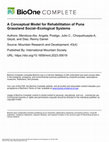
Mountain Research and Development, 2023
The impacts of both climate
change and socioeconomic
processes are driving the
degradation of mou... more The impacts of both climate
change and socioeconomic
processes are driving the
degradation of mountains
and the ecological services
they provide worldwide. In the
tropical Andes, compounding
glacier retreat, altered
hydrological and precipitation regimes (eg off-season alternation
of extreme dry and wet periods), and expansion of mining and
other land uses are modifying hydrological services. Although
initiatives to restore ecosystems and their services are
increasing, conceptual models emerging from experiences on the
ground are scarce. Based upon the experience of Peru’s National
Institute for Research on Glaciers and Mountain Ecosystems
(INAIGEM) in the Piuray Ccorimarca microbasin (Cusco) in combining
participatory action research and experiments at the plot scale, this
article elaborates a conceptual model for the rehabilitation of
hydrological services on the social–ecological systems of puna
grassland. The model proposes multiscale (plot–pilot–microbasin)
rehabilitation. At each level, the actions proposed include designing
plots, selecting sites, implementing restoration activities, and
evaluating and monitoring the sites. Our inductive model from the
ground and plot can inform rehabilitation of hydrological services on
puna grasslands elsewhere.
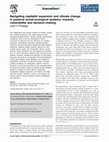
Current Opinion in Environmental Sustainability, 2021
The independent and synergic impacts of climatic change and capitalist expansion may render pasto... more The independent and synergic impacts of climatic change and capitalist expansion may render pastoral socialecological systems extinct. Climatic change compromises rangelands, while economic development fosters conversion of pastoral land into territories for capitalist expansion. Pastoralists' institutions regulate decisionmaking to socio-environmental change and shape adaptive responses, enabling mobile livestock rearing for using multiple grazing areas, and households' diverse income sources. These institutions are characterized by flexibility, such as mixed individual-collective water and land tenure regimes. However, capitalist-led reduction of land-based resources, the push for privatization and commodification of land and livestock hinder flexibility, and undermine pastoralists' institutions for decision-making; ultimately creating challenges for pastoralists' adaptive capacity. Research on the compound effects of the expanding global economy and climate change on pastoral social-ecological systems is needed to inform efforts constraining unregulated capitalist expansion, and policies for water and land security. Research, practice, and policies will improve pastoral social-ecological systems adaptability and resilience.
AGU Fall Meeting Abstracts, Dec 1, 2017
Bulletin of the American Meteorological Society
The Societal and Economics Research Application (SERA) Working Group of the World Meteorological ... more The Societal and Economics Research Application (SERA) Working Group of the World Meteorological Organization (WMO) World Weather Research Programme (WWRP) organized the first Weather and Society Conference, inviting the weather community to actively engage on critical themes to understand, analyze, and enhance the value of weather and climate services in society. The online conference ran over 2 weeks. Each session focused on a theme, ran for two hours, and included talks and discussion followed by a one-hour poster session.
Ministerio de Educación eBooks, 2002
Current Opinion in Environmental Sustainability

Pilpichaca is a campesino community of shepherds located in the highlands of Huancavelica in the ... more Pilpichaca is a campesino community of shepherds located in the highlands of Huancavelica in the southern Andes of Peru. Its lands are between 3900 and 5200 m elevation within an ecosystem characterized as puna or dry tropical alpine. This thesis analyzes how the community of Pilpichaca interacts with its environment over the course of three different spans of time (long-term, a recent decade, and present time). Using methods from the social sciences and Geographic Information Science, this thesis analyzes historical archives, remotely-sensed data, and current land-use practices in Pilpichaca. The combination of these two scientific traditions aimed to understand the socio-environmental dynamics of Pilpichaca. This thesis elucidates how high-elevation Andean pastoralism systems have responded to disturbances from the complex drivers of the 'outside world,' such as climate change. The main economic activity in Pilpichaca is the cultivation of mixed flocks of alpaca, llama, and sheep. The land-tenure system combines communal ownership of pastureland with the use of those lands by individual households. Pilpichaca's landscape is a key element in the pastoralist system that has been changing over the course of many centuries in conjunction with changes in the socioeconomic context. South American camelids were domesticated and became conditioned to life in the highland environment over many years; more recently, sheep were introduced in the Andes along with the Spanish tradition of livestock cultivation. Over the long-term period, these may be the most significant transformations in the Andean highlands. This thesis has used satellite imagery from 1990 and 2000 to analyze land use/ land cover change (LULCC), to establish the situation of different LULC classes, and to provide possible ecological succession figures. Over that decade (1990-2000), the landscape of Pilpichaca has changed dramatically demonstrating a multipath ecological succession. The most dynamic classes were Wetland (326%), Barren Light Vegetation Soil (314%), and Snow/Ice (-95%). Changes in LULC have been identified and contextualized by this thesis revealing that the causes of the changes occur at both global and local scales and result from social and environmental dynamics (e.g., diminishing snow/ice cover and increasing wetlands). Past, current and potential responses of the people to these changes are described and show that the community has a body of knowledge pertaining to their environment, and flexible but strict social and political relationships that manage the use of limited natural (e.g., pastures and water) and cultural (e.g., population and livestock) resources.Latin American Studie
The Latin American studies book series, 2023
Mountain Research and Development
BioOne Complete (complete.BioOne.org) is a full-text database of 200 subscribed and open-access t... more BioOne Complete (complete.BioOne.org) is a full-text database of 200 subscribed and open-access titles in the biological, ecological, and environmental sciences published by nonprofit societies, associations, museums, institutions, and presses.
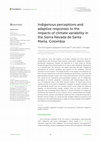
Frontiers in Climate
The exposure, risks, and impacts of climatic changes are most acute for marginalized and disenfra... more The exposure, risks, and impacts of climatic changes are most acute for marginalized and disenfranchised groups, particularly Indigenous Peoples. Worldwide, Indigenous Peoples are exposed to a wide range of climate threats that generate a broad spectrum of risks to their wellbeing. Responding to a request from the Arhuaco, this paper examines Arhuaco Indigenous perceptions of climatic variability, the impacts of this variability, and the response to such impacts. The empirical basis of the paper is the fieldwork on four Arhuaco settlements in the Sierra Nevada de Santa Marta, Colombia. We gathered data through surveys, semi-structured interviews, and focus groups. The results of our qualitative and quantitative analyses are: (1) Indigenous perception of climatic variability is consistent with meteorological data; (2) Loss of traditional crops is the most relevant impact; (3) Social and cultural capitals are the most used for adaptation strategies to climate variability; and (4) vuln...
El proceso de Cambio CLimático está transformando el ecosistema altoandino de una manera sin prec... more El proceso de Cambio CLimático está transformando el ecosistema altoandino de una manera sin precedentes. La mutua interdependencia de naturaleza y sociedad, a múltiples escalas, está produciendo modificaciones en el territorio altoandino, principalmente habitado por poblaciones campesinas. Desplazamientos de pisos ecológicos, procesos ecológicos aún no estudiados, y modificaciones de los regímenes hídricos son algunas de las manifestaciones ecológicas de dicha transformación
Science
There is much to learn from the farming practices of ants, termites, and other insects
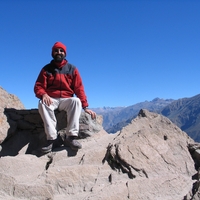


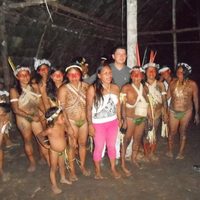


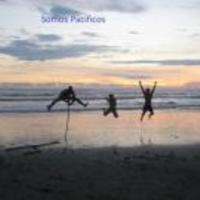




Uploads
Papers by Julio C . Postigo
páramo (Colombia), higher irregularity in precipitation and temperature reduces the quality of pasture
and cattle health. Data from surveys, semi-structured interviews, and focus groups were analyzed
to understand livestock farmers’ responses to the impacts of climatic variability. To estimate the
communities’ resilience in the páramo, we used the capitals framework, the Baseline Resilience
Indicator for Communities (BRIC), and cluster analysis. The responses of most households aim to
reduce the impacts of climatic variability on the production system, chiefly intensifying practices
such as the rotation of paddocks, livelihood diversification, purchase of grass, and buying and selling
livestock. Interestingly, farmers did not recognize the value of the types of capital for responding to
climatic variability. Results showed that the use of available physical, social, and economic capitals
render the farming system resilient. Our probit model estimated that economic and human capitals
are the largest and most significant contributors to communities’ capacity to respond to climatic
variability. However, pre-existing non-climatic vulnerabilities are also important. For example,
poverty hinders farmers from using their income in response to climatic variability. The place-based
measurements used in this research are easily understood and applicable by local policy makers to
address increasing climate variability.
the core of the conservation-development debate in the U.S. for over
fifty years. The Refuge case epitomizes how policies shape territories
governed by overlapping federal, congress, local, and Indigenous
regimes. For instance, between 2017 and 2023, the Refuge was
opened and closed to hydrocarbon development by two U.S.
Presidents. ANWR is among the largest environmental refuges in the
U.S. with oil reserve between 4.3 and 11.8 million barrels. Our
analysis of U.S. policies about the ANWR shows the contestation
between pro-environment and pro-oil development at the federal
and state levels. Federal policies of Republican and Democrat
administrations align with pro-drilling and pro-environment
positions, respectively. Alaskan policymakers are pro-drilling, which
puts them at odds with pro-environment legislators from
Democratic states. Tensions between Alaska and the Federal
government are about control and distribution of the oil revenue.
Further, Indigenous peoples are on different sides as well.
Traditional Gwich’in oppose development because it threatens their
way of life. Iñupiat favor oil development because oil revenue has
supported their modernized lifestyle. The fate of the ANWR will
shape what happens with protected areas in the U.S. and with
species across national boundaries.
change and socioeconomic
processes are driving the
degradation of mountains
and the ecological services
they provide worldwide. In the
tropical Andes, compounding
glacier retreat, altered
hydrological and precipitation regimes (eg off-season alternation
of extreme dry and wet periods), and expansion of mining and
other land uses are modifying hydrological services. Although
initiatives to restore ecosystems and their services are
increasing, conceptual models emerging from experiences on the
ground are scarce. Based upon the experience of Peru’s National
Institute for Research on Glaciers and Mountain Ecosystems
(INAIGEM) in the Piuray Ccorimarca microbasin (Cusco) in combining
participatory action research and experiments at the plot scale, this
article elaborates a conceptual model for the rehabilitation of
hydrological services on the social–ecological systems of puna
grassland. The model proposes multiscale (plot–pilot–microbasin)
rehabilitation. At each level, the actions proposed include designing
plots, selecting sites, implementing restoration activities, and
evaluating and monitoring the sites. Our inductive model from the
ground and plot can inform rehabilitation of hydrological services on
puna grasslands elsewhere.
páramo (Colombia), higher irregularity in precipitation and temperature reduces the quality of pasture
and cattle health. Data from surveys, semi-structured interviews, and focus groups were analyzed
to understand livestock farmers’ responses to the impacts of climatic variability. To estimate the
communities’ resilience in the páramo, we used the capitals framework, the Baseline Resilience
Indicator for Communities (BRIC), and cluster analysis. The responses of most households aim to
reduce the impacts of climatic variability on the production system, chiefly intensifying practices
such as the rotation of paddocks, livelihood diversification, purchase of grass, and buying and selling
livestock. Interestingly, farmers did not recognize the value of the types of capital for responding to
climatic variability. Results showed that the use of available physical, social, and economic capitals
render the farming system resilient. Our probit model estimated that economic and human capitals
are the largest and most significant contributors to communities’ capacity to respond to climatic
variability. However, pre-existing non-climatic vulnerabilities are also important. For example,
poverty hinders farmers from using their income in response to climatic variability. The place-based
measurements used in this research are easily understood and applicable by local policy makers to
address increasing climate variability.
the core of the conservation-development debate in the U.S. for over
fifty years. The Refuge case epitomizes how policies shape territories
governed by overlapping federal, congress, local, and Indigenous
regimes. For instance, between 2017 and 2023, the Refuge was
opened and closed to hydrocarbon development by two U.S.
Presidents. ANWR is among the largest environmental refuges in the
U.S. with oil reserve between 4.3 and 11.8 million barrels. Our
analysis of U.S. policies about the ANWR shows the contestation
between pro-environment and pro-oil development at the federal
and state levels. Federal policies of Republican and Democrat
administrations align with pro-drilling and pro-environment
positions, respectively. Alaskan policymakers are pro-drilling, which
puts them at odds with pro-environment legislators from
Democratic states. Tensions between Alaska and the Federal
government are about control and distribution of the oil revenue.
Further, Indigenous peoples are on different sides as well.
Traditional Gwich’in oppose development because it threatens their
way of life. Iñupiat favor oil development because oil revenue has
supported their modernized lifestyle. The fate of the ANWR will
shape what happens with protected areas in the U.S. and with
species across national boundaries.
change and socioeconomic
processes are driving the
degradation of mountains
and the ecological services
they provide worldwide. In the
tropical Andes, compounding
glacier retreat, altered
hydrological and precipitation regimes (eg off-season alternation
of extreme dry and wet periods), and expansion of mining and
other land uses are modifying hydrological services. Although
initiatives to restore ecosystems and their services are
increasing, conceptual models emerging from experiences on the
ground are scarce. Based upon the experience of Peru’s National
Institute for Research on Glaciers and Mountain Ecosystems
(INAIGEM) in the Piuray Ccorimarca microbasin (Cusco) in combining
participatory action research and experiments at the plot scale, this
article elaborates a conceptual model for the rehabilitation of
hydrological services on the social–ecological systems of puna
grassland. The model proposes multiscale (plot–pilot–microbasin)
rehabilitation. At each level, the actions proposed include designing
plots, selecting sites, implementing restoration activities, and
evaluating and monitoring the sites. Our inductive model from the
ground and plot can inform rehabilitation of hydrological services on
puna grasslands elsewhere.